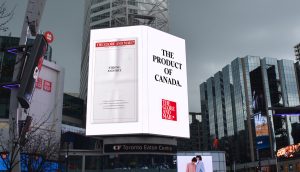
Canada’s federal and provincial governments are cautiously reopening economies as COVID-19 cases decline and the population recovers, with consumers only just now signalling their readiness to start venturing back out into the world.
Sarah Ivey, CEO and founder of Agents of Necessity, thinks that, on balance, Canada is a little more compliant and patient when it comes to the country’s economic recovery, which cascades down to how consumers are going to behave next.
Ivey believes that brands need to get comfortable with the “of two minds” phenomenon. That is, over the last three months, there’s been a consistent experience among Canadians, but now no one really knows the right way to go. Every time consumers do something “normal” they’re going to wonder if they should really be doing it. They could question whether it’s okay to pick up coffee or if they should make it at home for another week.
“Brands should be aware that this tension between normal and the ‘new normal,’ between indulgence and being responsible, is going to be perpetually at the forefront of consumers’ minds for at least the rest of the year,” says Ivey. “There’s going to be a lot of seesawing, which makes it difficult to get a read on the best approach. Case in point, I took a survey last night that was calibrated on understanding what type of mall shopping experience I would find comfortable right now. I think that’s why fast insight tools are going to be invaluable to brands – you just need a way to read the tea leaves fast.”
Richard Fofana, VP, strategy at UM, says brands can gain some perspective by looking broadly at where the Canadian economy sits on the COVID recovery path relative to other countries and comparing mobility rates.
However, Fofana says there are other granular factors that are more critical to shaping sound marketing decisions. “I think it’s important to get close to a brand’s business and sweat the small stuff.” For example, he says, UM is working with clients to look at local category demand, consumer cultural sentiment, regional regulations and brand equity, and is also conducting workshops “to identify growth opportunities and build custom solutions.”
The impact of COVID-19 is local, and the speed of recovery is different for each region, so taking a regional approach is how brands are going to come back, says Riina Clydesdale, president of OOH specialist Kinetic Worldwide. The agency has been meeting with clients and agency partners to present its Kinetic COVID-19 dashboard. The tool captures human movement against digital OOH boards to allow Kinetic to constantly reassess mobility in cities across the country and show clients when the time is right to enter the market.
“I’ve got the dashboard open right now and as I’m looking at Vancouver, I see that billboards, that are for roadside traffic, is down about 3%. Last week it was already up plus-4%,” says Clydesdale. “If I look at Toronto right now, it demonstrates the real differences in the regions. Toronto is showing at minus-40% right now at roadside.”
Tools like the dashboard enable Kinetic to look at each individual market and also educate clients on what types of media channels are effective right now. “We know what billboards are doing,” says Clydesdale. “We know what street furniture is doing. Obviously, grocery stories are packed right now and are at much more regular levels of traffic, but shopping malls are still down. We also know that cinemas are down, but we have some openings coming up in Alberta, so then we’ll be able to start to track movement in cinemas, spas and salons in the various markets.”
Nileen Ventura, VP, channel insights and discovery at Horizon Media in Toronto says the mobility data it tracks through it’s own dashboard also shows consumers signalling their level of readiness to get back to normal, and how they’re mentally preparing for the reopening of the economy.
“We think that brands should be a hero and take it slow,” says Ventura. “Our entire movement is dependent on the movement of the disease. I’m looking at our dashboard in terms of reported cases and deaths – the trajectory is going down, but the speed is not drastically down therefore the government mimics that rate. What that tells us [is that brands should] be the hero, take it slow and reassure consumers every step of the way.”
She says the agency has seen Canadians be very pragmatic and approach recovery slower than their US counterparts. “When we’ve seen a measurement of fear of catching the virus, it was less about themselves and more about their family members. Canadians are willing to sacrifice by not moving around by staying put and not visiting grandparents and parents because of their concern about the safety of others before themselves.”


















